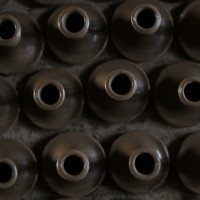Close to the heart of Cairo, specifically in Islamic Cairo, behind the Multi-Religious Compound (Magma’ Al-Adyan) lies an area renowned for its pottery industry. There, a number of workshops exist, manufacturing various forms of clay day-in and day-out.
Am Ramadan is one among many workers who came all the way from Upper Egypt, bringing with him his pottery profession. Residents of the area call him the ‘King of Clay’. The king inherited the profession from his grandparents. He is a father of six boys and six girls, all of whom have in turn been raised to become potters.
Pottery involves many steps. They begin by cutting the clay into circles, then the circles are placed on a piece of wood connected to a pole that is connected to another piece of wood. This allows workers to spin the apparatus using their feet, while using their hands to form the clay and create different shapes of pots. Once the final shape is formed, it is placed in an oven to solidify.
Pots are decorated and polished before or after incineration. The Chinese became known for their handmade pottery between 206 BCE and 220 CE. They made small statues and pottery objects, even fireplaces, and exported them to India and the Middle East. In the Americas, pottery was also handmade and coloured using natural dyes.
The pottery industry is one of the many traditional handicrafts in Egypt. Archaeological studies conducted on ancient pots revealed that the craft has been present for thousands of years. The population used the pots to cook and for water conservation.
The craft also exists in many Gulf countries, like the United Arab Emirates. Clay varies by region. The clay used in the UAE is red, green, and yellow.
When the workload came overwhelm them, craftsmen required assistants. They recruited other people to work with them and delegated the various tasks, giving each worker a specialty.
Clay is prepared in various steps. It is first brought to the workshop, then stirred using a stick to smooth it. Some water is added and the mix is left for two hours. Workers then stir the mix and take out impurities using sieves. The output is distributed among the three rectangular pools that are linked together through holes. The clay is then left to solidify.
The craft is inhered down from generation to generation in the same family. Beginners learn by watching for a week or a month. After observing, they are enlisted as apprentices to the craftsmen, usually to move around tools and pots. When the apprentice adapts to the craft, they begin by decorating completed pots, while learning how to make small samples, such as cups and plates. Eventually, they start making larger shapes.
If the person seeking to learn the craft is an outsider to the family, they do not get paid for the time of training; the craft they acquire is considered their payment.
Photos by Ahmed Hendawy , Mohamed Omar and Asmaa Gamal

































